Your Guide to Stakeholder Analysis Matrix: Master Project Management
While managing a project, many factors affect the viability and success of it. One such factor is stakeholder management.
Stakeholder management helps identify, engage, analyze, and manage individuals or groups of people who hold an interest or can be affected by your project.
The stakeholder analysis matrix helps you conduct effective stakeholder management. It is a visualization tool that helps you map out and analyze involved individuals, groups, etc.
This article will equip you to:
- The fundamental components of a stakeholder analysis matrix
- How to create and implement this powerful tool effectively
- Real-world applications and best practices I’ve gathered from working with Fortune 500 companies
- Common pitfalls to avoid
What is the Stakeholder Analysis Matrix?
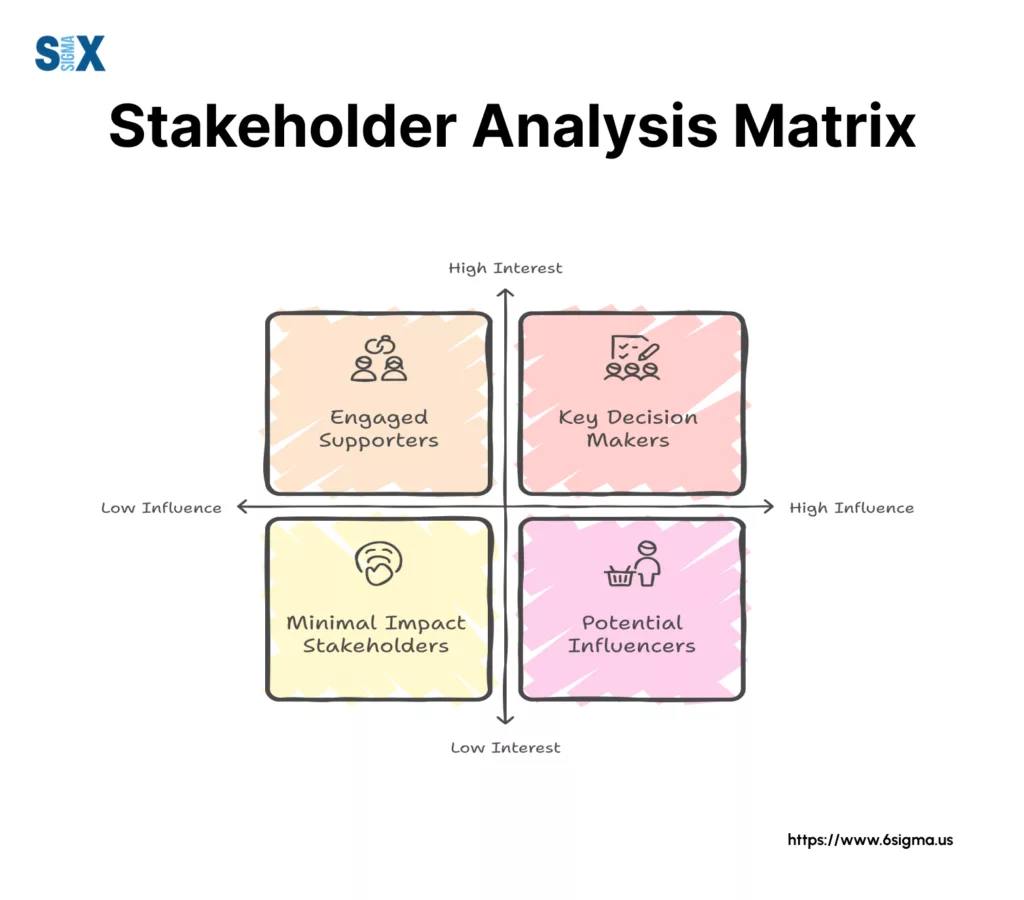
The stakeholder analysis matrix in project management helps categorize and analyze stakeholders based on their relationship to your project via a strategic framework. This tool is particularly valuable because it helps you:
- Identify and prioritize stakeholders systematically
- Understand stakeholder interests and influence levels
- Develop targeted engagement strategies
- Allocate resources effectively
- Minimize project risks related to stakeholder management
Build Your Lean Skills
Enroll in our Lean Six Sigma White Belt Certification course to build your Lean and Six Sigma skills. Take the first step towards process improvement!

Types of Stakeholder Matrices
In our workshops and consulting work, I typically focus on three main types of stakeholder matrices, each serving a specific purpose:
1. Power/Interest Grid
Despite being one of the most commonly used stakeholder analysis matrices, it proves successful in many cases. It plots stakeholders on two axes:
Power: Their ability to influence the project
Interest: Their level of concern about the project’s outcomes
This is particularly useful in large-scale organizational changes, such as Six Sigma-driven quality control initiatives, where a six sigma certification equips teams with standardized methodologies for sustainable improvements.
2. Influence/Impact Matrix
This variation focuses on:
Influence: How much they can affect project implementation
Impact: How much the project affects them
This matrix proves invaluable in navigating complex organizational structures.
3. Salience Model
This more sophisticated model considers three dimensions:
- Power
- Legitimacy
- Urgency
I often recommend this model for complex projects with multiple stakeholder groups.
For professionals tackling complex stakeholder dynamics, Six Sigma Green Belt certification provides advanced tools for analyzing multidimensional challenges like power, legitimacy, and urgency.
The five pillars of stakeholder analysis that I’ve consistently emphasized in my training sessions are:
- Identification: Who are your stakeholders?
- Assessment: What are their interests and influence levels?
- Prioritization: How should you rank their importance?
- Engagement Strategy: How will you manage each stakeholder group?
- Monitoring and Adjustment: How will you track and adapt your approach?
Through my experience leading international projects, I’ve learned that these pillars remain consistent across cultures and industries, though their application might vary based on local context.
Want to better understand the relationships between stakeholders and project outcomes?
Our C&E Matrix course will teach you how to systematically analyze and prioritize key variables in your projects. Perfect for people wanting to enhance their stakeholder analysis skills.
Creating a Stakeholder Analysis Matrix: A Step-by-Step Guide
I’ve refined the process of creating a stakeholder analysis matrix into a practical, repeatable approach. Let me walk you through how to draw a stakeholder matrix that will serve as your roadmap for project success.
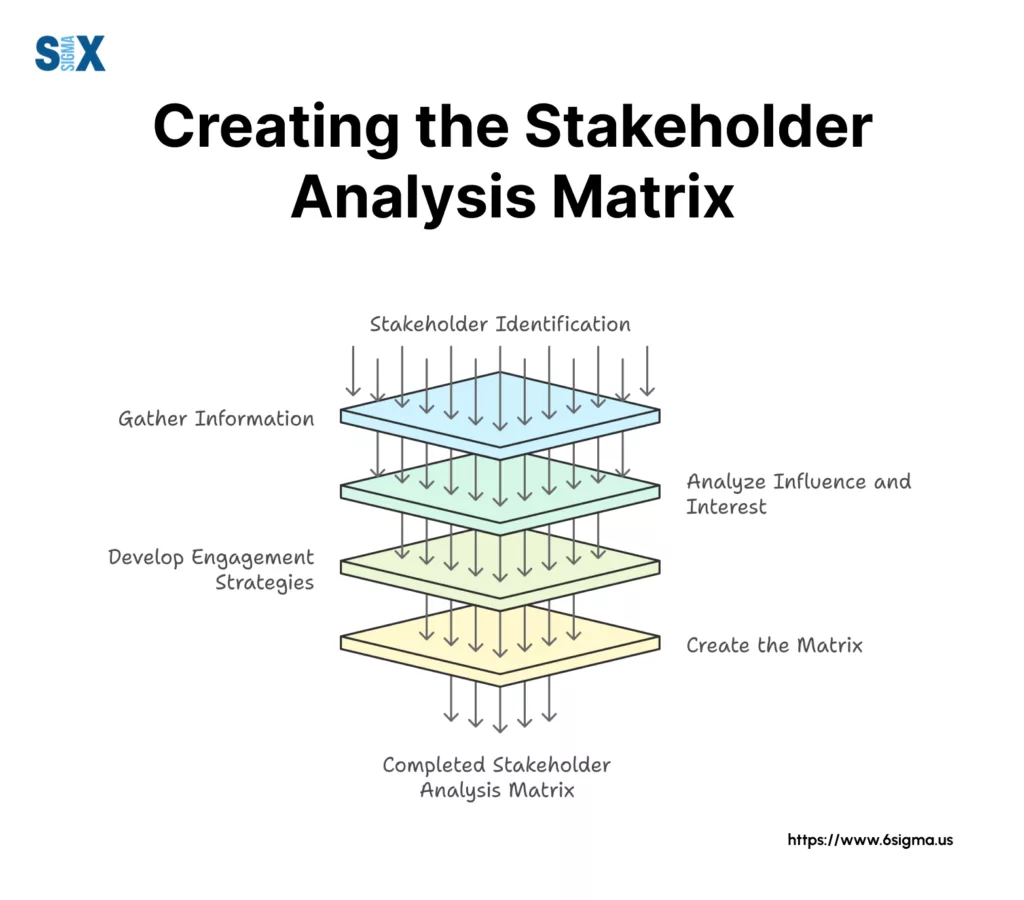
Identify Stakeholders
The first crucial step is comprehensive stakeholder identification. During my time leading a major process improvement project, we used these key questions to identify stakeholders:
- Who will be directly affected by the project?
- Who has influence or power over the project?
- Who has an interest in the project’s success or failure?
- Who controls relevant resources?
Pro Tip: Don’t rush this stage. I’ve seen many projects stumble because they missed critical stakeholders early on.
Gather Information
Once you’ve identified your stakeholders, it’s time to collect detailed information about each one. I’ve found these data points essential:
- Current position on the project
- Level of influence in the organization
- Specific interests and concerns
- Potential impacts on their role or department
- Historical relationship with similar initiatives
Analyze Stakeholder Influence and Interest
This is where your stakeholder matrix example begins to take shape. Based on the information gathered, assess each stakeholder’s:
- Power/Influence Level (High or Low)
- Interest Level (High or Low)
- Current attitude (Supportive, Neutral, or Resistant)
Develop a simple 1-5 scoring system for each dimension, making the analysis more objective and comparable.
Develop Engagement Strategies with the Stakeholder Analysis Matrix
Based on where stakeholders fall in your matrix, develop appropriate engagement strategies:
- High Power/High Interest: These are your key players. When I led projects at Intel, we ensured these stakeholders received frequent, detailed updates and were involved in key decisions.
- High Power/Low Interest: Keep these stakeholders satisfied but don’t overwhelm them with details.
- Low Power/High Interest: Keep these stakeholders well-informed and use them as project advocates.
- Low Power/Low Interest: Monitor these stakeholders but avoid excessive communication.
Create the Matrix
Time to draw your stakeholder matrix. Here’s my tried-and-tested approach:
- Create a two-dimensional grid
- Label the X-axis as “Interest” and the Y-axis as “Power”
- Divide the grid into four quadrants
- Plot stakeholders on the grid using clear identifiers
- Color-code or use symbols to indicate additional factors (like current attitude)
Master Process Mapping like a Pro!
Learn how to create clear, effective process maps that will enhance your stakeholder analysis and project management skills.
Best Practices for Stakeholder Engagement and Communication
Creating a stakeholder analysis matrix is only half the battle. The real success comes from how effectively you use this tool to engage and communicate with your stakeholders. Here are some proven strategies:
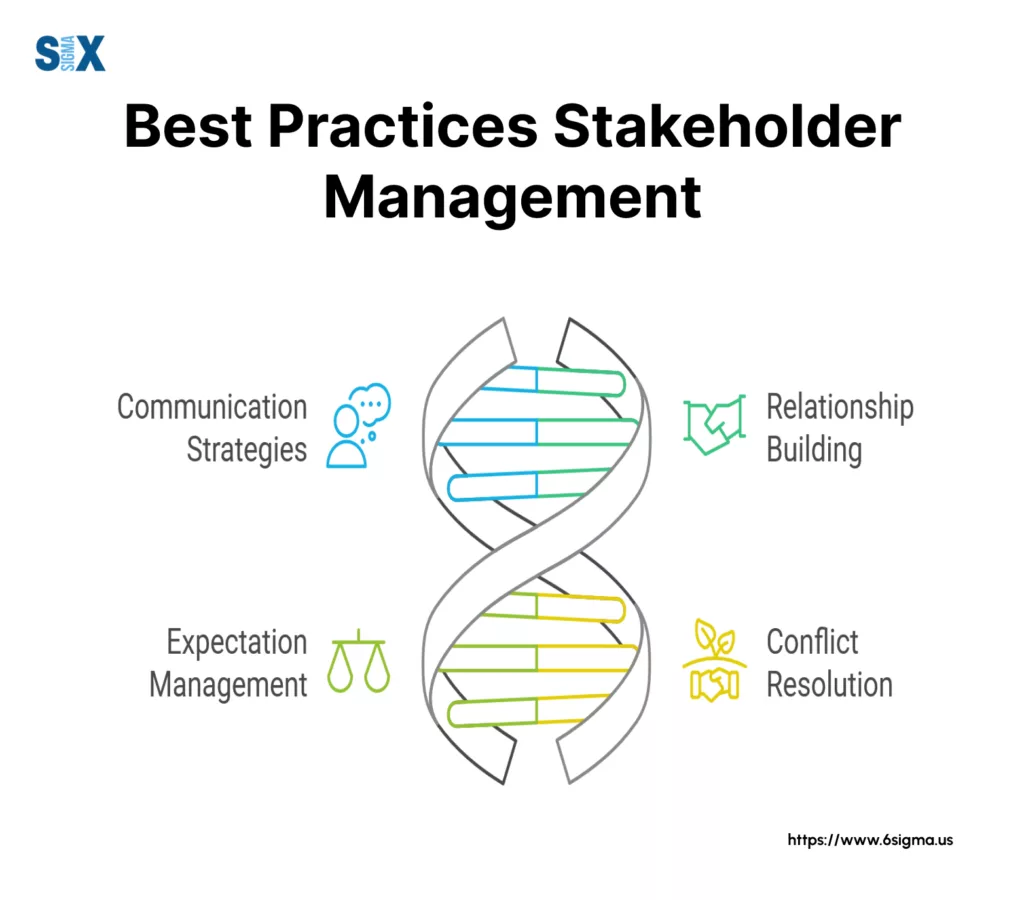
Tailoring Communication Strategies
One size doesn’t fit all when it comes to stakeholder communication.
- Clarity: Ensure your messages are clear and concise
- Consistency: Maintain regular communication rhythms
- Context: Provide relevant background information
- Customization: Adapt your communication style to each stakeholder
Create different communication templates for technical teams versus executive stakeholders. The technical teams received detailed progress reports, while executives got high-level summaries focused on business impacts.
Building and Maintaining Relationships using the Stakeholder Analysis Matrix
Your stakeholder analysis matrix should inform your relationship-building strategy. Here’s what I’ve found works best:
- High-Power Stakeholders: Schedule regular one-on-one meetings
- Technical Stakeholders: Organize focused workshop sessions
- Cross-functional Teams: Facilitate collaborative problem-solving sessions
- External Stakeholders: Plan formal review meetings with clear agendas
Relationship-building approaches may need cultural adaptation while maintaining these core principles.
Managing Expectations
One of the most valuable lessons I learned was the importance of proactive expectation management. Here’s the approach:
- Document and share project scope clearly
- Set realistic timelines and milestones
- Communicate constraints and limitations upfront
- Regular status updates aligned with your stakeholder analysis matrix
- Address concerns promptly and transparently
Resolving Conflicts using the Stakeholder Analysis Matrix
Conflicts are inevitable in any project, but your stakeholder analysis matrix can help you navigate them effectively. Here’s a conflict resolution framework:
- Identify the root cause using stakeholder mapping
- Understand each stakeholder’s perspective and interests
- Develop solutions that address multiple stakeholder needs
- Document agreements and follow-up actions
- Monitor resolution effectiveness
Identifying root causes of conflicts is a skill honed through root cause analysis training, which complements stakeholder analysis by addressing underlying issues systematically.
Pro Tip: I always keep a “stakeholder temperature check” as part of my project management toolkit. This involves regular pulse checks with key stakeholders identified in your matrix to catch potential issues before they escalate.
Common Pitfalls and How to Avoid Them
Numerous projects stumble due to common yet avoidable mistakes. Let me share some critical pitfalls I’ve encountered and the solutions to address them.
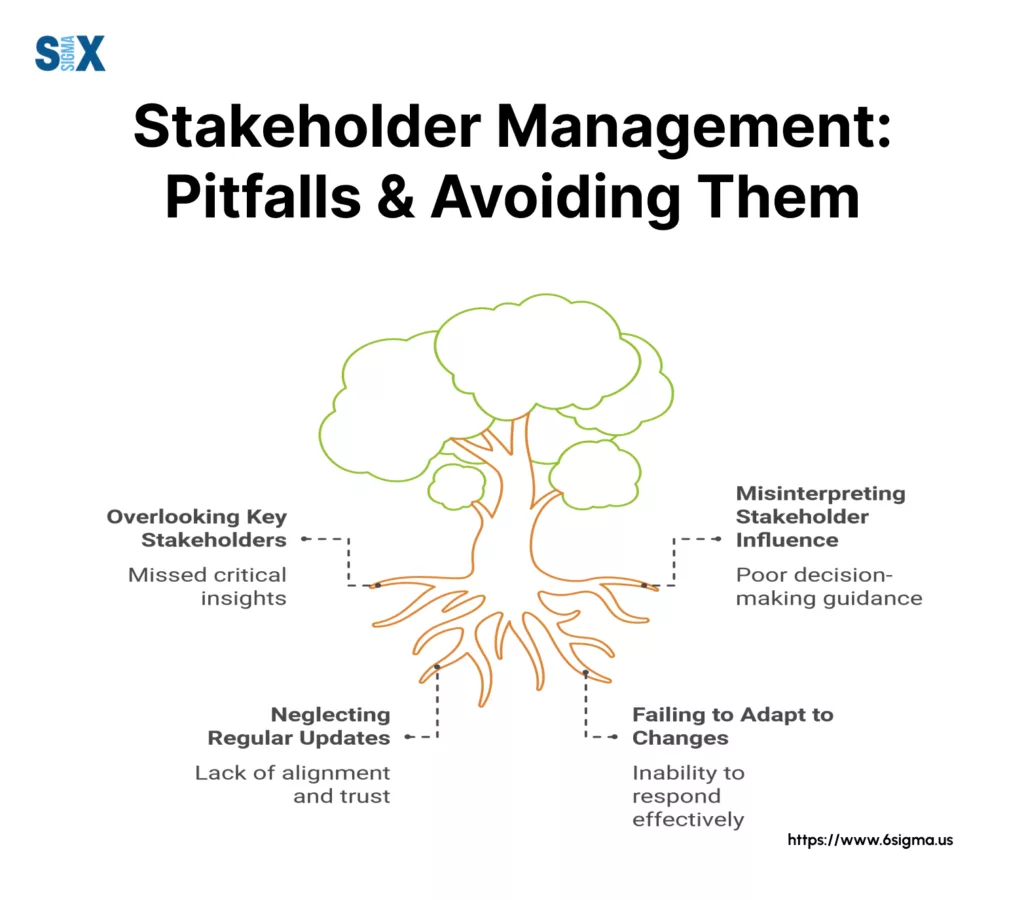
Overlooking Key Stakeholders
One of the most costly mistakes I’ve seen is failing to identify all relevant stakeholders. Here’s how to avoid this:
- Cast a wider net initially – it’s easier to narrow down than to add stakeholders later
- Consult with department heads and team leaders across functions
- Consider indirect stakeholders who might influence project outcomes
- Review organizational charts and informal influence networks
Pro Tip: During a major process improvement project, we discovered a crucial stakeholder three months in. The resulting project delays taught me to always conduct thorough stakeholder mapping sessions at project initiation.
Misinterpreting Stakeholder Influence
Authority doesn’t always equal actual influence. Here’s what to watch for:
- Don’t rely solely on organizational hierarchies
- Consider informal influence networks
- Account for technical expertise and knowledge
- Evaluate stakeholder relationships and alliances
For instance, while working with a semiconductor and circuit manufacturing organization, we identified that a junior engineer had more practical influence over implementation than their superior due to their technical expertise and peer relationships.
Neglecting Regular Updates to the Stakeholder Analysis Matrix
Your stakeholder analysis matrix should be a living document. How you should develop this schedule:
- Monthly review of stakeholder positions
- Quarterly comprehensive analysis
- Immediate updates following organizational changes
- Regular validation of engagement strategies
Failing to Adapt to Changing Stakeholder Dynamics
Organizations aren’t static, and neither should your stakeholder management approach be. Here’s what I recommend based:
- Monitor organizational changes
- Track shifting priorities and interests
- Reassess stakeholder influence periodically
- Adjust engagement strategies accordingly
The best way to conduct stakeholder analysis is to make it an ongoing process rather than a one-time exercise.
Common Red Flags to Watch For:
- Stakeholders becoming disengaged
- Unexpected resistance to project initiatives
- Communication breakdowns
- Misaligned expectations
Case Studies: Stakeholder Analysis in Action
These cases demonstrate how this powerful tool can be adapted across different sectors while maintaining its core effectiveness.
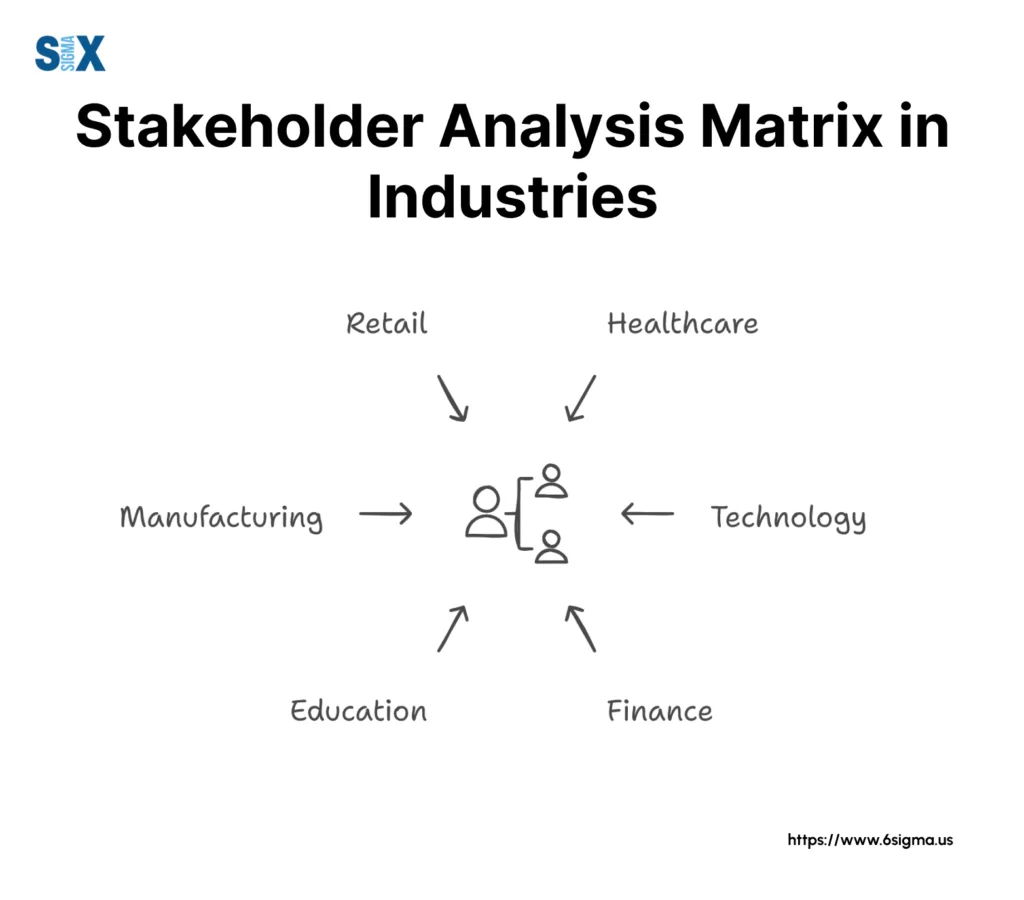
Technology Sector Example
During my work with a technology giant on a major supply chain optimization project, we developed a comprehensive stakeholder analysis matrix that proved crucial to the project’s success. Here’s what it looked like:
Key Stakeholders Identified:
- IT Development Teams
- Operations Managers
- Global Suppliers
- Regional Distribution Centers
- End Users
Our matrix revealed an unexpected insight: while senior IT managers held formal power, mid-level operations managers had significant informal influence over implementation success. We adjusted our engagement strategy accordingly, resulting in:
- 30% faster implementation time
- 85% stakeholder satisfaction rate
- Successful integration across three continents
Healthcare Industry Case Study
While working with a major healthcare provider, we faced unique challenges implementing process improvements in a highly regulated environment. Our stakeholder analysis matrix included:
Primary Stakeholders:
- Medical Staff
- Administrative Personnel
- Regulatory Bodies
- Patient Representatives
- Insurance Partners
The matrix helped us identify potential conflicts between clinical requirements and administrative efficiency. We developed a balanced approach that:
- Maintained compliance standards
- Improved process efficiency by 40%
- Increased stakeholder buy-in through targeted engagement
Government Project Illustration
My experience with a government institution provided an excellent example of how a stakeholder analysis matrix can navigate complex organizational structures. The project involved modernizing training procedures across multiple bases.
Matrix Components:
- Command Structure Leadership
- Training Officers
- Technical Specialists
- External Contractors
- Compliance Officers
Key Outcomes:
- Successfully managed multiple chains of command
- Achieved 95% stakeholder alignment
- Completed project ahead of schedule
Want to Strengthen Your Project Management Foundation?
Our Define Phase course teaches you essential tools for stakeholder identification and project selection – crucial skills for effective stakeholder management. Start building your expertise today!
Integration of the Stakeholder Analysis Matrix with Project Management Methodologies
A stakeholder analysis matrix must be adaptable to different project management approaches. Let’s look at how to effectively integrate stakeholder analysis across various methodologies.
Stakeholder Analysis Matrix in Agile Projects
In Agile environments, stakeholder management takes on a more dynamic character. During my work with software development teams, we modified the traditional stakeholder analysis matrix to accommodate Agile’s iterative nature:
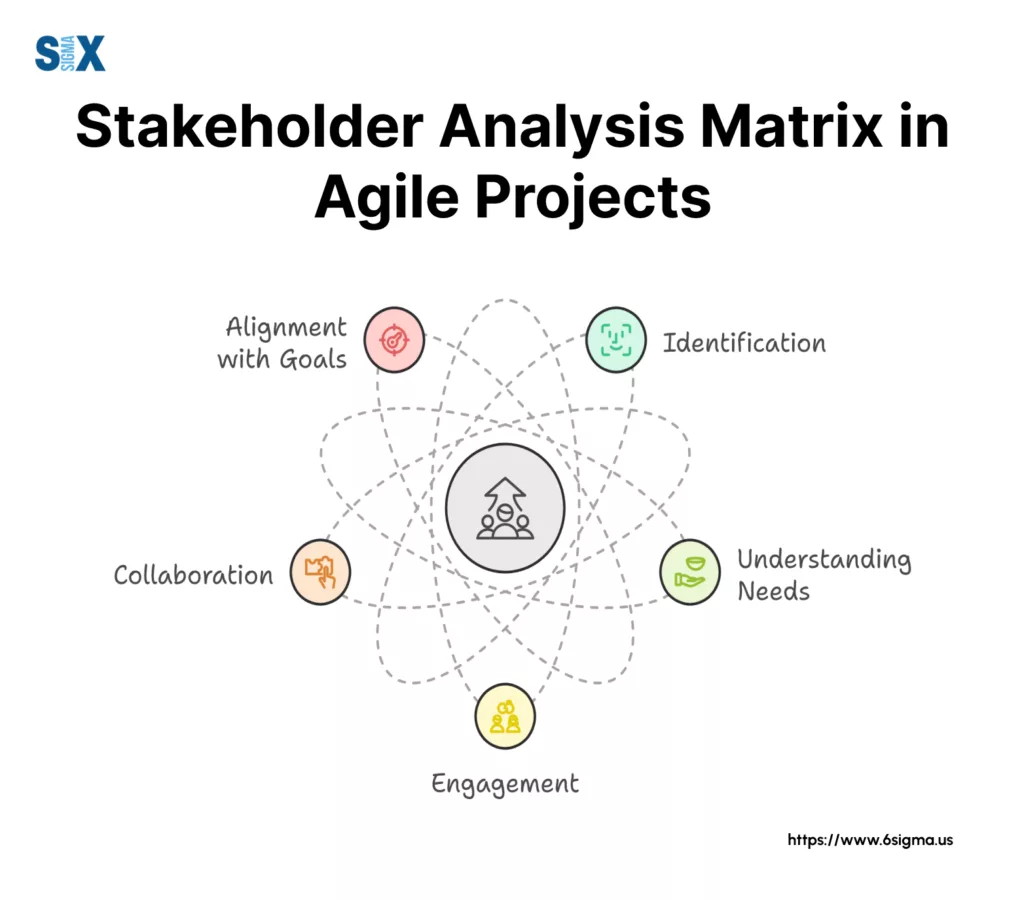
Sprint-Based Stakeholder Management:
- Weekly stakeholder position updates
- Rapid feedback loops
- Flexible engagement strategies
- Regular reprioritization of stakeholder needs
Pro Tip: Create a digital version of your project stakeholder matrix that can be easily updated during sprint reviews and retrospectives.
Incorporating Stakeholder Management in Traditional PM Frameworks
In traditional project management environments, stakeholder analysis integration follows a more structured approach:
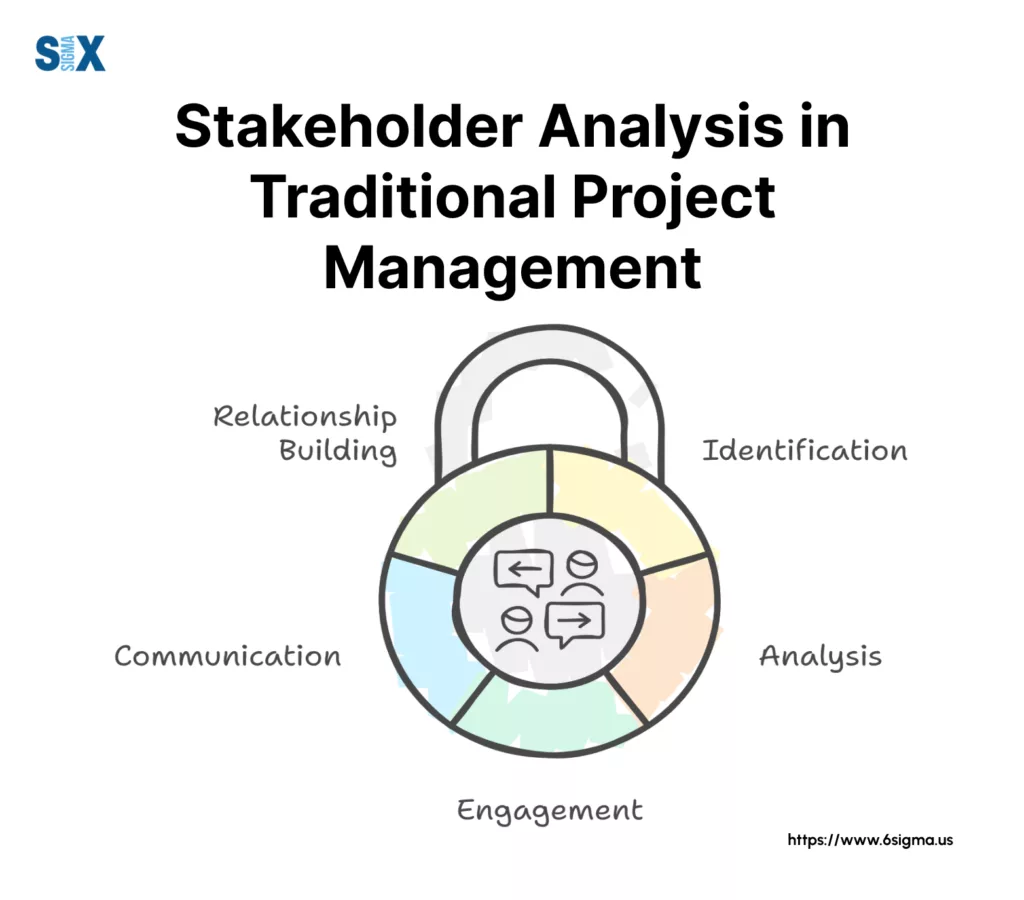
Phase-Gate Integration:
- Initiation: Comprehensive stakeholder identification
- Planning: Detailed analysis and strategy development
- Execution: Regular monitoring and engagement
- Closing: Stakeholder satisfaction assessment
Balancing Stakeholder Needs Across Different Methodologies
One of the most valuable lessons I’ve learned while working with hybrid project management approaches is the importance of flexibility. Here’s my framework for balancing stakeholder needs:
Core Principles (Applicable to All Methodologies):
- Regular stakeholder assessment
- Clear communication channels
- Documented engagement strategies
- Measurable success metrics
Methodology-Specific Adaptations:
Agile:
- Focus on rapid stakeholder feedback
- Frequent small adjustments
- Enhanced collaboration tools
Traditional:
- Formal communication plans
- Structured review cycles
- Comprehensive documentation
Hybrid:
- Balanced approach combining elements of both
- Flexible engagement strategies
- Adaptable documentation levels
The key to successful integration lies in maintaining the core elements of your stakeholder analysis matrix while adapting the implementation approach to match your project methodology.
Tools and Software for Stakeholder Analysis
Having implemented stakeholder analysis matrices across various organizations, I’ve had the opportunity to work with numerous tools and software solutions. Let me share insights from my experience to help you choose the right tool for your needs.
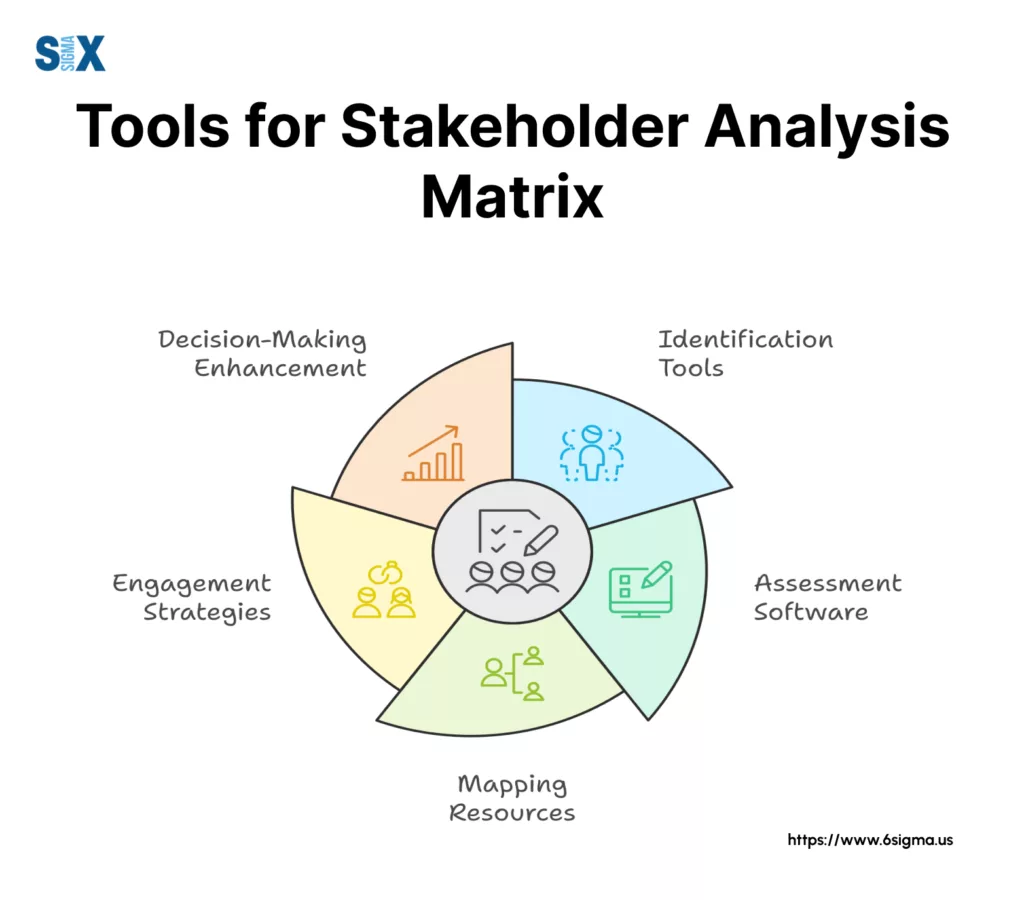
Popular Stakeholder Analysis Tools
Through my work, I’ve found these tools particularly effective:
Enterprise-Level Solutions:
- Stakeholder Circle®: Excellent for complex projects
- Microsoft Power BI: Great for data visualization
- Jira with Stakeholder Add-ons: Ideal for Agile environments
Mid-Range Options:
- Excel Templates: Surprisingly effective for most projects
- Smartsheet: Good balance of features and usability
- Lucidchart: Excellent for visual representation
Specialized Tools:
- StakeholderMap.com: Focus on stakeholder mapping
- MindManager: Great for relationship visualization
Comparison of Features and Functionalities of Stakeholder Analysis Matrix
Based on my experience implementing these tools across different organizations, here’s what to look for:
Essential Features:
- Stakeholder mapping capabilities
- Communication tracking
- Influence/Interest visualization
- Report generation
- Collaboration features
Nice-to-Have Features:
- Integration with project management software
- Real-time updates
- Mobile Accessibility
- Custom fields and metrics
Tips for Choosing the Right Tool
I’ve developed these criteria for tool selection:
Project Size and Complexity:
- Small projects: Excel or basic mapping tools
- Medium projects: Mid-range solutions
- Large/Enterprise projects: Full-featured platforms
Budget Considerations:
- Free options: Excel templates, Google Sheets
- Moderate investment: Specialized mapping tools
- Enterprise investment: Full-featured solutions
Team Capabilities:
- Consider your team’s technical expertise
- Evaluate training requirements
- Assess integration needs
Remember, the best tool is one that your team will use consistently. In my experience, I’ve seen expensive solutions fail because they were too complex, while simple Excel-based tools succeeded due to their accessibility and ease of use.
Advanced Techniques and Emerging Trends
Let’s look at the emerging trends that are reshaping how we approach the stakeholder analysis matrix.
AI-Powered Stakeholder Analysis
AI is transforming stakeholder analysis in fascinating ways:
- Predictive Analytics: AI algorithms now forecast stakeholder behavior patterns
- Automated Relationship Mapping: Machine learning identifies hidden connections
- Real-time Sentiment Analysis: Natural language processing tracks stakeholder attitudes
- Dynamic Risk Assessment: AI-driven models predict potential conflicts
Pro Tip: While AI tools are powerful, I always emphasize they should complement, not replace, human judgment in stakeholder management.
Professionals pursuing Six Sigma Black Belt certification often leverage AI-powered tools to enhance predictive stakeholder analytics, blending technical expertise with leadership skills.
Stakeholder Analysis in Remote/Distributed Teams
The global shift to remote work has revolutionized stakeholder management. Based on my experience, here’s what works:
Digital Collaboration Tools:
- Virtual stakeholder mapping platforms
- Real-time collaboration features
- Automated update notifications
- Cross-timezone communication management
Virtual Engagement Strategies:
- Structured online feedback channels
- Digital stakeholder forums
- Virtual relationship-building activities
Ethical Considerations in Stakeholder Management
Through my work with government institutions and private corporations, here are the ethical guidelines:
- Transparency in stakeholder classification
- Fair representation of diverse interests
- Protection of sensitive stakeholder information
- Balanced power distribution in decision-making
Stakeholder Analysis for Sustainability and CSR Initiatives
I’ve seen stakeholder analysis evolve to include:
Environmental Impact Considerations:
- Carbon footprint tracking
- Environmental stakeholder mapping
- Sustainability metrics integration
Social Responsibility Metrics:
- Community impact assessment
- Social value creation measurement
- Long-term sustainability goals
Emerging Trends
Looking ahead, I see several emerging trends that will shape the future of stakeholder analysis:
- Blockchain for stakeholder relationship tracking
- Augmented reality for stakeholder visualization
- Integration with ESG (Environmental, Social, and Governance) frameworks
- Enhanced data privacy and security measures
Correctly managing stakeholder relationships can play a key between project success and failure.
Keep in mind that successful project management isn’t just about the right tech expertise, it’s about understanding and engaging with the people who influence or are influenced by your initiatives!
SixSigma.us offers both Live Virtual classes as well as Online Self-Paced training. Most option includes access to the same great Master Black Belt instructors that teach our World Class in-person sessions. Sign-up today!
Virtual Classroom Training Programs Self-Paced Online Training Programs






